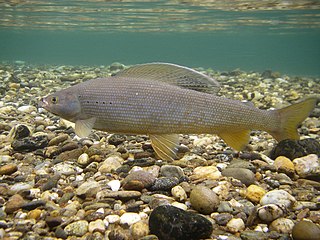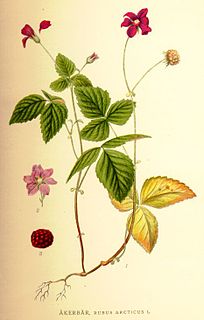
The Arctic hare is a species of hare highly adapted to living in the Arctic tundra and other icy biomes. The Arctic hare survives with shortened ears and limbs, a small nose, the fat that makes up close to 20% of its body, and a thick coat of fur. It usually digs holes in the ground or under the snow to keep warm and to sleep. Arctic hares look like rabbits but have shorter ears, are taller when standing, and, unlike rabbits, can thrive in extreme cold. They can travel together with many other hares, sometimes huddling with dozens or more, but are usually found alone, sometimes taking more than one partner. The Arctic hare can run up to 60 kilometres per hour (40 mph).

Thymallus is a genus of freshwater fish in the salmon family Salmonidae; it is the only genus of subfamily Thymallinae. The type species is Thymallus thymallus, the grayling. The species in the genus are generically called graylings, but without qualification this also refers specifically to T. thymallus.

Arctic grayling is a species of freshwater fish in the salmon family Salmonidae. T. arcticus is widespread throughout the Arctic and Pacific drainages in Canada, Alaska, and Siberia, as well as the upper Missouri River drainage in Montana. In the U.S. state of Arizona, an introduced population is found in the Lee Valley and other lakes in the White Mountains. They were also stocked at Toppings Lake by the Teton Range and in various lakes in the high Uinta Mountains in Utah, as well as various alpine lakes of the Boulder Mountain chain in central Idaho.

The Arctic shrew, also known as the blackback shrew or saddlebacked shrew, is a medium-sized shrew found in Canada and the northern United States. Separate species status has been proposed for the maritime shrew which is found in New Brunswick and Nova Scotia and had been considered to be a subspecies of the Arctic shrew. The tundra shrew was formerly considered to be a subspecies of the Arctic shrew.

Rubus arcticus, the Arctic bramble or Arctic raspberry, is a species of slow-growing bramble belonging to the rose family, found in arctic and alpine regions in the Northern Hemisphere.

Kotelny Island is part of the Anzhu Islands subgroup of the New Siberian Islands located between the Laptev Sea and the East Siberian Sea in the Russian Arctic. It is administratively and municipally part of Bulunsky District.
Marinobacter is a genus of Proteobacteria found in sea water. They are also found in a variety of salt lakes. A number of strains and species can degrade hydrocarbons. The species involved in hydrocarbon degradation include M. alkaliphilus, M. arcticus, M. hydrocarbonoclasticus, M. maritimus & M. squalenivorans.
Pedobacter arcticus is a species of facultative psychrophile bacteria isolated from Arctic soil. It is gram-negative, short rod-shaped and motile, with type strain A12(T). Its genome has been sequenced.
Virgibacillus arcticus is a moderately halophilic, endospore-forming bacterium originally isolated from permafrost in the Canadian high Arctic. Its type strain is Hal1T.
Ji Hee Kim is an Antarctic researcher, best known for being the Principal Investigator for comprehensive environmental monitoring and construction of the long term environmental database at South Korea's King Sejong Station.
Dendronotus arcticus is a species of sea slugs, a dendronotid nudibranch, a shell-less marine gastropod mollusc in the family Dendronotidae.
Cyclobacterium is a mesophilic, neutrophilic, chemoorganotrophic and aerobic bacterial genus from the family of Cytophagaceae. Cyclobacterium bacteria occur in marine habitats
Dyadobacter arcticus is a Gram-negative, psychrotolerant, rod-shaped, aerobic and non-motile bacterium from the genus of Dyadobacter which has been isolated from Arctic soil from Svalbard Archipelago in Norway.
Aureimonas glaciistagni is a Gram-negative, rod-shaped, aerobic and motile bacteria from the genus of Aurantimonas which has been isolated from a melt pond from Arctic sea ice.
Shewanella arctica is a Gram-negative and anaerobic bacterium from the genus of Shewanella which has been isolated from sediment from the Arctic.
Marinobacterium maritimum is a Gram-negative, rod-shaped, aerobic and motile bacterium from the genus of Marinobacterium which has been isolated from sediments from the Arctic.
Marinobacterium profundum is a Gram-negative, rod-shaped and motile bacterium from the genus of Marinobacterium which has been isolated from deep-sea sediments from the Sea of Japan in Korea.
Phaeobacter arcticus is a psychrophilic, Gram-negative, rod-shaped and motile bacteria from the genus of Phaeobacter which has been isolated from the Arctic.
Halocynthiibacter is a genus of bacteria in the family Rhodobacteraceae.
Sediminicola arcticus is a Gram-negative, psychrophilic, rod-shaped and non-motile bacterium from the genus of Sediminicola which has been isolated from deep-sea sediments from the Arctic Ocean.





